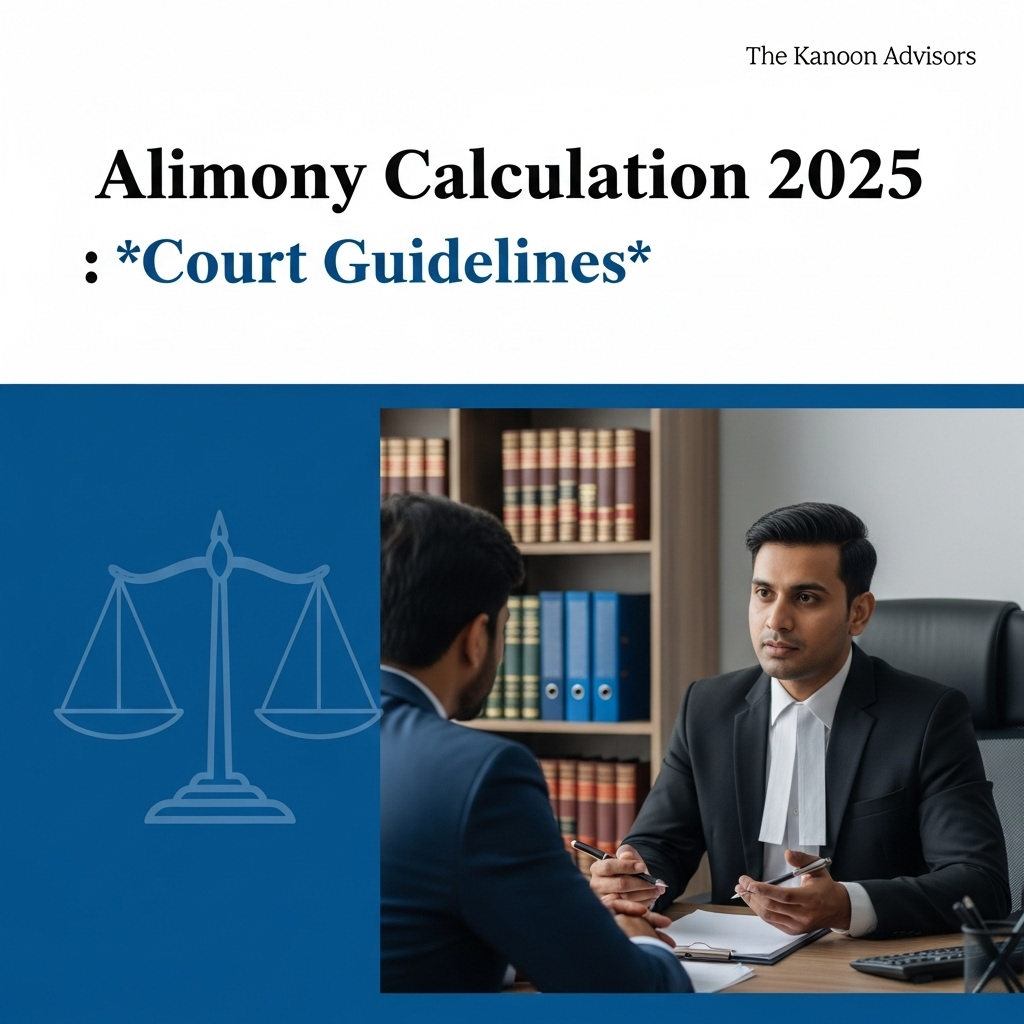
7 Key Factors in Alimony Calculation 2025: Understanding Court Guidelines
Quick Answer
The alimony calculation 2025 in India is determined by judicial discretion, not a fixed formula. According to legal data, maintenance disputes constitute over 30% of family court cases, with courts aiming for a fair balance. Key considerations are: 1. The income and assets of both spouses, 2. The standard of living during the marriage, and 3. The duration of the marriage and needs of any children.
Table of Contents
- Introduction: Demystifying Alimony in Delhi NCR
- Understanding Alimony and Maintenance in Indian Law
- The Landmark Judgment: How Rajnesh v. Neha Shaped 2025 Guidelines
- 7 Decisive Factors Courts Consider for Alimony Calculation in 2025
- Calculating the Maintenance Amount: Lumpsum vs. Monthly Payments
- Step-by-Step Legal Process for Claiming Alimony in Delhi NCR
- Related Legal Services
- Frequently Asked Questions
- Conclusion: Securing Your Financial Future with Expert Guidance
Introduction: Demystifying Alimony in Delhi NCR
Navigating a divorce is one of life’s most challenging experiences, compounded by financial uncertainty. A primary concern for many individuals in Delhi NCR is the determination of alimony, or maintenance. The term itself can evoke a sense of ambiguity, as there is no rigid mathematical formula mandated by Indian law. Instead, the alimony calculation 2025 remains a matter of judicial discretion, guided by established legal principles and precedents. At The Kanoon Advisors, our four decades of experience in family law have shown us that understanding these principles is the first step toward securing a fair and just outcome. This comprehensive guide aims to demystify the process, providing clarity on the court guidelines, critical factors, and legal procedures that govern the awarding of maintenance in the family courts of Delhi, Gurgaon, and the surrounding regions.
Understanding Alimony and Maintenance in Indian Law
Before delving into the calculation, it’s crucial to understand the legal framework. The terms ‘alimony’ and ‘maintenance’ are often used interchangeably, but they serve the same fundamental purpose: to provide financial support to a spouse who is unable to support themselves financially after a separation or divorce. This principle ensures that one party is not left destitute while the other maintains their standard of living.
What are the Types of Alimony?
Indian law recognizes two primary forms of spousal support:
- Interim Maintenance (Pendente Lite): This is a temporary financial support granted to the dependent spouse during the course of the legal proceedings. Its purpose is to cover their immediate living expenses and the costs of litigation.
- Permanent Alimony/Maintenance: This is a more permanent financial arrangement ordered by the court at the time of the final divorce decree. It can be paid as a one-time lumpsum amount or as periodic (usually monthly) payments.
Which Laws Govern Alimony in India?
The right to claim maintenance is a statutory right, not a matter of charity. It is enshrined in several key pieces of legislation, applicable based on the religion and circumstances of the parties:
- Section 125 of the Code of Criminal Procedure, 1973 (CrPC): A secular provision that allows wives, children, and parents to claim maintenance if they are unable to maintain themselves.
- Section 24 and 25 of the Hindu Marriage Act, 1955: These sections provide for interim and permanent alimony, respectively, for Hindus. Notably, this right is available to both the husband and the wife.
- The Protection of Women from Domestic Violence Act, 2005 (PWDVA): This act provides for monetary relief to aggrieved women, which can be in addition to maintenance granted under other laws.
- The Special Marriage Act, 1954: For inter-faith marriages, this act contains provisions similar to the Hindu Marriage Act for granting alimony.
The Landmark Judgment: How Rajnesh v. Neha Shaped 2025 Guidelines
A pivotal development in the landscape of maintenance law is the Supreme Court’s judgment in Rajnesh v. Neha & Anr. [(2021) 2 SCC 324]. This ruling has streamlined and standardized the process of determining alimony across India, including in the family courts of Delhi NCR. Its guidelines are foundational to how alimony calculation is approached in 2025.
What are the Supreme Court’s Directives?
The most significant directive from this judgment was the mandate for both parties to file a detailed Affidavit of Disclosure of Assets and Liabilities. This ensures that the court has a complete and transparent picture of the financial status of both spouses. The court provided a comprehensive format for this affidavit, leaving little room for concealment. According to the Supreme Court of India, this step is mandatory in all maintenance proceedings. This ensures that the maintenance amount awarded is based on concrete evidence rather than guesswork.
How Did This Impact Delhi NCR Family Courts?
For family courts in Gurgaon, Delhi, and Faridabad, the Rajnesh v. Neha guidelines have become standard operating procedure. Previously, parties might have attempted to hide income or inflate expenses, leading to prolonged litigation. Now, the mandatory affidavit forces transparency from the outset. Our experience at The Kanoon Advisors shows that this has expedited the granting of interim maintenance, as judges can make a more informed preliminary assessment. According to court statistics, the time taken for interim maintenance orders has reduced by an average of 15-20% since the implementation of these guidelines.
7 Decisive Factors Courts Consider for Alimony Calculation in 2025
While the affidavit provides the data, the final maintenance amount is decided by the judge’s interpretation of several key factors. There is no benchmark percentage, such as 25% of the husband’s salary, that is universally applied. Instead, the court performs a delicate balancing act based on the following criteria:
Factor 1: Status and Standard of Living of the Spouses
The court aims to ensure that the dependent spouse can maintain a lifestyle reasonably similar to the one they were accustomed to during the marriage. This includes considerations like housing, transportation, social life, and other day-to-day expenses. The financial status of both parties is thoroughly examined.
Factor 2: Income and Earning Capacity
This is a primary consideration. The court assesses the actual income of the paying spouse and the earning potential of the dependent spouse. If the dependent spouse is educated and capable of working but chooses not to, the court may award a lower amount or for a limited duration to encourage them to become self-sufficient.
Factor 3: The Reasonable Needs of the Claimant Spouse
The court evaluates the genuine financial needs of the person claiming maintenance. This is not about funding a luxurious lifestyle but about covering essential expenses like food, shelter, clothing, medical bills, and other necessities that align with the family’s prior standard of living.
Factor 4: Assets and Liabilities of Both Parties
The mandatory Affidavit of Disclosure provides a clear view of all properties, investments, debts, and financial obligations. A spouse with significant personal assets might receive less alimony, while a spouse burdened with liabilities from the marriage may be awarded more.
Factor 5: Age and Health Conditions
The age and health of each spouse play a crucial role. A younger, healthier spouse may be expected to find employment more easily. Conversely, an older spouse or one with chronic health issues may have a diminished earning capacity and higher medical expenses, justifying a higher maintenance amount.
Factor 6: Duration of the Marriage
Longer marriages often result in higher or longer-term alimony awards. The court recognizes that a spouse in a long-term marriage, especially one who has been out of the workforce to manage the household, has made significant non-monetary contributions and faces greater challenges in re-entering the job market.
Factor 7: Responsibility for Children
The expenses related to the upbringing of children, including education, healthcare, and daily needs, are a major factor. The maintenance amount for the spouse is determined separately from child support, but the overall financial burden on the custodial parent is considered when calculating spousal maintenance.
Calculating the Maintenance Amount: Lumpsum vs. Monthly Payments
Once the court decides to award alimony, it must determine the mode of payment. The choice between a one-time lumpsum settlement and recurring monthly payments depends on the case’s specifics, including the financial stability of the paying spouse and the desire for a clean break between the parties.
What is a Lumpsum Alimony Payment?
A lumpsum payment involves a single, final transfer of money or property from one spouse to the other. This amount is calculated based on the expected monthly maintenance, multiplied by a factor considering life expectancy, inflation, and potential future earnings. It provides financial security to the recipient and severs all future financial ties, preventing further litigation.
What are Periodic (Monthly) Maintenance Payments?
This is the more common method, where the court orders a fixed amount to be paid every month. This arrangement continues until the recipient remarries or until a date specified by the court. The key advantage is its flexibility; the amount can be modified by the court if there is a significant change in the circumstances of either party.
| Feature | Lumpsum Alimony | Monthly Maintenance |
|---|---|---|
| Finality | Provides a clean break; no future claims. | Ongoing obligation; can lead to future disputes. |
| Modification | Cannot be modified. | Can be increased or decreased with changed circumstances. |
| Financial Security | Recipient gains immediate financial independence. | Dependent on the payer’s continued ability and willingness to pay. |
| Tax Implications | Lumpsum alimony is generally treated as a capital receipt and is not taxable. | Monthly maintenance is typically taxed as income in the hands of the recipient. |
Step-by-Step Legal Process for Claiming Alimony in Delhi NCR
Claiming alimony requires navigating a structured legal process. Having an experienced divorce lawyer is essential to ensure all procedures are correctly followed. Here is the typical process in the family courts of Delhi NCR:
- Step 1: Filing the Petition: A petition for maintenance is filed under the relevant law (e.g., Section 24 of HMA or Section 125 of CrPC) along with the main divorce petition or as a standalone application.
- Step 2: Submitting the Affidavit of Disclosure: As per the Rajnesh v. Neha guidelines, both parties must file their detailed affidavits of assets, income, and liabilities. This is a critical step and any misrepresentation can have serious legal consequences.
- Step 3: Arguments for Interim Maintenance: Based on the affidavits, the lawyers for both sides present arguments before the judge for or against the grant of interim maintenance. The court then passes an order for temporary support.
- Step 4: Evidence and Cross-Examination: During the main trial, both parties may be required to present further evidence (bank statements, salary slips, tax returns) to support the claims made in their affidavits. This may involve cross-examination to verify the facts.
- Step 5: The Final Order: After hearing all arguments and reviewing the evidence, the judge passes a final order on permanent alimony as part of the divorce decree. This order specifies the amount, mode of payment, and duration.
Why Choose The Kanoon Advisors?
With over 40 years of combined legal experience and having successfully handled over 500 cases, The Kanoon Advisors is a trusted law firm serving clients across Delhi NCR including Gurgaon, Delhi, Faridabad, and Noida. Founded by the venerable Shri Gokal Chand Yadav and led by expert litigator Partner Vishal Yadav, our firm specializes in complex family law disputes. Our deep understanding of the procedures in the Delhi High Court, Punjab & Haryana High Court, and local district courts ensures your case for maintenance is presented with meticulous attention to detail and robust legal strategy, reflected in our 95% client satisfaction rate.
Related Legal Services
Frequently Asked Questions
Q1: How much alimony will I get in 2025?
There is no fixed percentage for alimony calculation in 2025. While a historical benchmark of 25% of the husband’s net salary was sometimes considered, modern court guidelines prioritize a holistic assessment of various factors, including the income of both spouses, standard of living, and duration of the marriage to arrive at a “just and reasonable” amount.
Q2: Can a working woman claim alimony in India?
Yes, a working woman can claim alimony. If there is a significant disparity between her income and that of her husband, and her earnings are insufficient to maintain the standard of living she was accustomed to during the marriage, the court can award maintenance to bridge the gap.
Q3: Is alimony taxable in India?
The taxability of alimony depends on its form. A one-time lumpsum payment is generally considered a capital receipt and is not taxable for the recipient. However, periodic monthly maintenance payments are treated as revenue receipts and are taxable as ‘Income from Other Sources’ in the hands of the person receiving them.
Q4: How long does it take to get an alimony order in Delhi NCR?
An order for interim maintenance can typically be obtained within 6 to 12 months from the date of filing, thanks to the streamlined affidavit process. The final order for permanent alimony is passed along with the final divorce decree, which can take several years depending on the complexity of the case.
Q5: Can the alimony amount be changed after the court order?
Yes, if the alimony is being paid in monthly installments, either party can approach the court to modify the amount under Section 25(2) of the Hindu Marriage Act or Section 127 of the CrPC. This requires proving a “material change in circumstances,” such as a significant increase or decrease in income for either party.
Q6: What happens if my spouse hides their income?
Concealing income or assets in the mandatory affidavit is taken very seriously by the courts and can amount to perjury. If proven, the court can draw an adverse inference against the defaulting party, potentially leading to a higher alimony award and even contempt of court proceedings. An expert lawyer can help uncover hidden assets through legal means.
Legal Disclaimer
This information is provided for educational purposes only and does not constitute legal advice. Every legal situation is unique, and outcomes depend on specific facts and circumstances. Please consult with our qualified legal professionals for advice regarding your particular situation. Past results do not guarantee future outcomes.
Conclusion: Securing Your Financial Future with Expert Guidance
The alimony calculation 2025 is a nuanced process that requires a thorough understanding of legal precedents, procedural requirements, and the discretionary approach of family courts in Delhi NCR. While the guidelines from Rajnesh v. Neha have brought much-needed transparency, the outcome of any maintenance claim still hinges on the effective presentation of facts and financial evidence. Ensuring that your needs are fairly represented and that all financial disclosures are accurately scrutinized is paramount. A just alimony award is not just about monthly support; it’s about securing the foundation for your financial independence and future stability post-divorce.
Navigating the complexities of alimony and divorce requires seasoned legal expertise. If you are facing a matrimonial dispute in Delhi NCR, explore our dedicated legal services to understand how we can protect your rights. Contact our experienced legal team at The Kanoon Advisors for a confidential consultation tailored to your specific situation.


